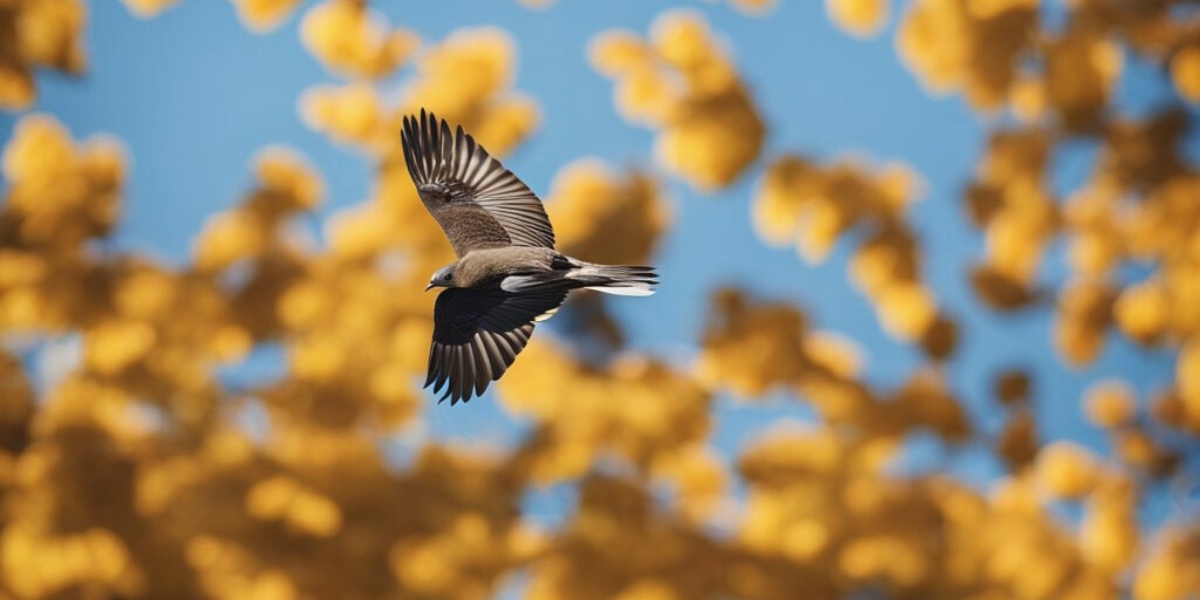As summer winds down, an incredible phenomenon begins ramping up across North America: fall bird migration! Each year, billions of birds undertake journeys between their breeding and wintering grounds in a massive seasonal movement. But when exactly does this monumental migration take place? What factors influence timing for different species? Let’s explore when birds head south in autumn and the best ways to observe and support these intrepid travelers along their flyways.
Why do birds migrate?
Multiple factors trigger birds to migrate each fall:
Seasonal Changes
Most birds time migration using seasonal cues like daylight duration, angle of sun, and stars. As the days shorten after the solstice, hormonal changes prompt birds to fatten up and migrate south. Changes in weather and temperatures also provide important signals.
Food Availability
Birds migrate to regions where they can find adequate food through the winter. Insect populations crash and other food sources decline in northern areas as winter nears. Birds must travel to habitats where resources are more plentiful.
Nesting Needs
Birds migrate to reach optimal nesting locations each spring. Rather than tough out harsh winters, they head south to warmer areas conducive for winter survival. This allows them to get a head start on spring breeding preparations.
These cyclical environmental forces drive migration patterns year after year in seasonal rhythm. Next let’s look at fall migration windows.
Fall Migration Timeframes
Different species migrate in waves, starting as early as July and ending as late as December. Here’s an overview:
Early Fall Migrants
Some birds migrate south quite early, including shorebirds, swifts, hummingbirds, and swallows. Most early migrants complete their journeys by September.
- Semipalmated Sandpipers
- Black Terns
- Ruby-throated Hummingbirds
- Barn Swallows
Mid-Fall Migrants
The majority of migration occurs from September through October as songbirds like warblers, vireos, and flycatchers move south:
- American Redstart
- Red-eyed Vireo
- Wood Thrush
- Scarlet Tanager
Late Fall Migrants
Certain species wait longer to migrate, often not departing until November. Late migrants include sparrows, bluebirds, raptors, and blackbirds:
- Dark-eyed Juncos
- American Robins
- Red-tailed Hawks
- Rusty Blackbirds
These windows provide a general framework, but other factors adjust the exact timing.
Factors Influencing Migration Timing
Several elements cause migration timing to vary year-to-year:
Weather Conditions
Birds wait for favorable tailwinds. Inclement weather like storms and headwinds may delay migration, while ideal winds can accelerate passage south.
Stopover Duration
Time spent refueling along migration routes can lengthen the overall trip duration. Poor conditions at stopovers can prolong journeys.
Age and Experience
Adults migrate before juveniles to claim winter sites. Older birds migrate closer to optimal timing. Young birds may migrate late and deviate from ideal routes.
These variables mean migration timing is quite fluid. Next, we’ll break down what species move through each month.
Month-by-Month Fall Migration Calendar
Here is an overview of key migratory events unfolding across the continent each month:
August Bird Migration
- Shorebirds move south from Arctic breeding grounds. Semipalmated Plovers, Short-billed Dowitchers, and Red-necked Phalaropes pass through wetlands.
- Swallows such as Bank, Tree, and Cliff congregate in large flocks before moving south.
- Early warbler migrants like Tennessee, Chestnut-sided and Black-and-white start heading south.
- Local Purple Martins undergo pre-migratory staging, massing in roosts before migration.
September Bird Migration
- Neotropical songbirds are in full migration. Warblers, vireos, tanagers, grosbeaks and more move through backyards and woodlands.
- Broad-winged Hawks stream past hawk watch sites by the thousands along east coast routes.
- Ruby-throated Hummingbirds largely disappear from the U.S. and Canada by mid-September.
- Waterfowl like Blue-winged Teal and Northern Shovelers arrive at southern wintering grounds.
October Bird Migration
- Sparrows move south in force, with White-crowned, White-throated, Vesper and Savannah Sparrows all on the move.
- Winter finches like Pine Siskins and Purple Finches stage northward migrations from the boreal forest into the lower 48 states.
- Lingering warblers pass through like Palm, Orange-crowned, and Wilson’s.
- American Robins withdraw from northern parts of breeding range as food sources diminish.
November Bird Migration
- Ducks continue moving south, including Northern Pintails, Green-winged Teal, Buffleheads and Common Goldeneyes.
- Rough-legged Hawks, Snowy Owls and other raptors associated with the Arctic tundra migrate south in search of food as winter sets in.
- Open country sparrows like American Pipits move south out of alpine breeding grounds.
- Irruptive winter finches like evening grosbeaks conduct southerly migrations from boreal forests if food crops fail.
These highlights give a continental overview. But timing nuances exist across regions.
Regional Variations in Timing
Different areas see different windows of migration based on location:
Northeast
Most Neotropical migrants pass through the Northeast from mid-August through October. But some songbirds like junco and winter wren migrate later into November. Raptors peak from late-September into mid-October.
Southeast
The Southeast sees earlier fall warbler migration in August and September. But being farther south, some migrants like Scarlet Tanagers and Indigo Buntings linger into October. Large numbers of swallows pass through heading to the tropics.
Midwest
The Midwest fall migration peaks from September to early November as birds funnel south through the broad Central Flyway. Shorebirds pass through in July and August. Peak songbird migration spans September and October with late migrants straggling into November.
Northwest
The Northwest sees southbound shorebirds departing Arctic grounds in July and August. Songbirds move through areas to the south starting in August with most gone by October. Winter arrivals like snow geese and trumpeter swans appear as early as September.
Southwest
In mountainous Southwest areas, hummingbirds and swallows migrate south starting in August. Songbirds follow suit in September and October. Sparrows, including Lark and Black-throated, migrate through desert regions October into November. Winter residents establish territories beginning in September.
These offer general timeframes to expect key migrant groups by region. But each year brings variations. Now let’s look at migration strategies of common backyard birds.
Migration Strategies of Common Birds
Here are some insight into how familiar species fit into seasonal movement patterns:
Robins
American Robins are early spring arrivals on breeding grounds. Accordingly, they are also early fall departers, migrating south in September and October. But small numbers overwinter in northern areas where berry crops persist.
Hummingbirds
Most Ruby-throated Hummingbirds vacate the U.S. and southern Canada by mid-September. Anna’s and Rufous Hummingbirds migrate out of the Pacific Northwest into October and November. Stragglers may linger at feeders.
Warblers
September brings warbler migration in earnest for most species, withа waves passing south through October. But certain warblers like Palm and Yellow-rumped often migrate later into November.
Sparrows
Different sparrow species migrate across a broad span. Chipping Sparrows peak in October while White-throated Sparrows largely move October through
November. Dark-eyed Juncos and Fox Sparrows mainly migrate November into December.
Swallows
Most swallows migrate south in August and September after breeding, though some species like Barn Swallows linger into October. Purple Martins stage in roosts before migration in August.
Thrushes
Thrush migration peaks from September to early November, with Hermit Thrush and Wood Thrush among the earliest movers and American Robins and Varied Thrushes migrating later.
Raptors
Sharp-shinned and Cooper’s Hawks start migrating early, in August and September. Broad-winged Hawks stream past hawk watches in September. Red-tailed Hawks, Rough-legged Hawks, and Bald Eagles migrate later into November.
Ducks
Early duck migrants like Blue-winged Teal and Northern Shovelers arrive on southern wintering grounds by September. But many ducks like Northern Pintails and Buffleheads migrate south later, peaking in November.
Blackbirds
Some blackbirds like Bobolinks migrate relatively early in September and October after breeding. Others, including Rusty Blackbirds and Red-winged Blackbirds, move south later in November into December.
These examples showcase the diversity of migration timing across species. Now let’s explore how to prepare your yard for the influx of birds.
Preparing Your Yard for Migrating Birds
You can make your yard more welcoming to migrating birds by:
Food and Water
Supply feeders with high fat foods like suet and sunflower seeds. Offer fresh water for drinking and bathing.
Shelter and Nesting
Provide thickets and clusters of vegetation for roosting spots and protection from predators. Put up nest boxes for early claim.
Safety
Reduce window collisions and keep cats indoors. Limit pesticide use and night lighting that could disturb migrating birds.
With some simple efforts, you can create an oasis for migrators! Next let’s look at some ways to engage.
Ways to Observe and Support Migration
Here are some suggestions for taking part in migration:
Citizen Science
Contribute observations to eBird and Journey North. Participate in migration counts or volunteer at banding stations.
Birdwatching Hotspots
Visit noted migration stopover sites to see diverse concentrations of birds. Hawk watches offer raptor sightings.
Conservation
Support groups like the National Audubon Society that protect bird habitats. Get involved in local habitat restoration efforts.
However you take part, fall bird migration is a marvelous phenomenon!
Conclusion
While specific timing changes annually, birds principally migrate south during August through November each fall to escape harsh conditions and seek out plentiful resources for winter. Paying attention to weather patterns, food availability, and age of birds can provide clues to migration timing. Provide stopover resources in your yard, observe at migration hotspots, and support conservation efforts to engage with this amazing seasonal event.

